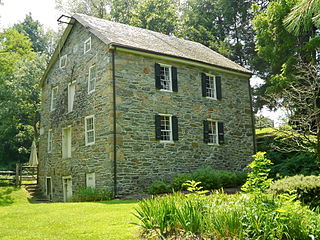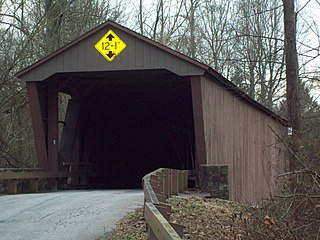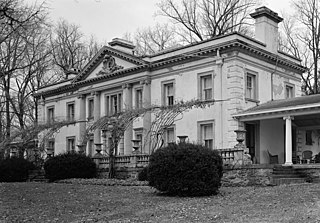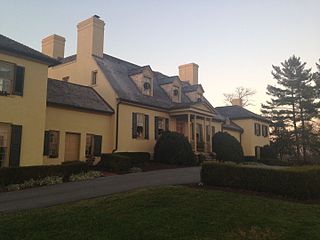
There are more than 1,500 properties and districts listed on the National Register of Historic Places in the U.S. State of Maryland. Each of the state's 23 counties and its one county-equivalent has at least 20 listings on the National Register.
Monkton is an unincorporated community in northern Baltimore County, Maryland, United States. It has a population of approximately 4,856 people. The community is 35 square miles (91 km2) in area, with approximately 138 inhabitants per square mile (53/km2). As an unincorporated area, Monkton has no legally defined boundaries, and its ZIP code (21111) includes a portion of adjacent Harford County.
Ladew Topiary Gardens are nonprofit gardens with topiary located in Monkton, Maryland. The gardens were established in the 1930s by socialite and huntsman Harvey S. Ladew (1887–1976), who in 1929 had bought a 250-acre (100 ha) farm to build his estate. The house and gardens are open April through October, weekdays and weekends; an admission fee is charged.
Cardiff is an unincorporated community in Harford County, Maryland, United States. The zip code for the area is 21160. The community name is taken from the Capital city of Wales.

The Mill Green Historic District is a National Register of Historic Places listed community located in Harford County, Maryland. The district consists of a small cluster of privately owned historic homes and buildings including a historic mill. The district is located at the junction of Mill Green Road and Prospect Road. Broad Creek flows through the district. The historic district designation was established in 1993.

Lauraville is a neighborhood in northeast Baltimore, Maryland. The neighborhood is bounded on the east by Harford Road, on the north by Echodale Avenue, on the south by Argonne Drive and Herring Run Park, and on the west side by Morgan Park and Morgan State University, with East Cold Spring Lane passing through the center of Lauraville.

St. James Church is a historic Episcopal church located at Monkton, Baltimore County, Maryland, US.

Maryland Route 138 is a state highway in the U.S. state of Maryland. The state highway runs 9.24 miles (14.87 km) from MD 45 in Hereford east to MD 23 near Shawsville. MD 138 connects northern Baltimore County with northwestern Harford County via the community of Monkton on Gunpowder Falls. The first section of the state highway was built east of Monkton in the 1910s. The remainder of MD 138 was built west of Monkton in the mid-1920s and east of Monkton in the early to mid-1930s. The state highway through Monkton was maintained by Baltimore County from the late 1960s to the mid-1990s, during which the highway was relocated at Gunpowder Falls.

The Jericho Covered Bridge is a Burr arch through truss wooden covered bridge near Jerusalem, Harford County and Kingsville, Baltimore County, in Maryland, United States and near historic Jerusalem Mill Village. The bridge was constructed in 1865 across the Little Gunpowder Falls. This bridge is 88 feet (27 m) long and 14.7 feet (4.5 m) wide and is open to traffic.

Liriodendron is a historic home and estate located at Bel Air, Harford County, Maryland, United States. It was the summer home of Laetitia and Dr Howard Kelly, a successful surgeon and founding member of the Johns Hopkins Medical College, and comprises the mansion named Liriodendron; the Graybeal-Kelly House; a c. 1835 bank barn; a c. 1898 carriage house; a c. 1850 board-and-batten cottage; and five other outbuildings including a corn crib, a smokehouse, two ice houses, and a shed. The 2+1⁄2-story, stuccoed brick mansion was designed by the Baltimore architectural firm of Wyatt and Nolting in the Georgian Revival style and constructed about 1898. The 2+1⁄2-story Georgian-style Graybeal-Kelly House, built about 1835, was the manor house for the farm until the mansion was constructed. It is used as a wedding, conference, and arts facility.

Rigbie House, also known as "Phillip's Purchase", is a historic home located at Berkley, Harford County, Maryland. It is a 1+1⁄2-story, frame and stone structure built about 1781. It was one of a series of forest outposts fortified against the Indians and representing Lord Baltimore’s claim of 1632 to land extending north to the 40th parallel. In April 1781, it was the place where the Marquis de Lafayette’s officers quelled a mutiny that might have prevented his army of New England troops, who had been headed homeward, from turning south again to join General Greene and General Washington at Yorktown, in which case that battle might never have been fought.

Gladden Farm, also known as Gladden-Roming Stone House, is a historic home and farm complex located in Street, Maryland. The complex includes three historically-significant structures: a large five-bay rubblestone bank house with Federal detailing, a one-story rubblestone spring house, and a one-story board-and-batten frame shop.
Whiteford is an unincorporated community in Harford County, Maryland, United States. The community has historically had a strong Welsh heritage, which is reflected in the local architecture.
Corbett Historic District is a national historic district at Monkton, Baltimore County, Maryland, United States. It is a group of 20 dwellings, a doctor's office, a former store/post office, a brothel, and a school comprising the village of Corbett in rural northern Baltimore County, Maryland. Most of the buildings date from about 1880 through about 1920. They reflect the period of Corbett's development as a stop on the Northern Central Railway, and a local commercial, industrial, and transportation center for the surrounding farms.

Bel Air Courthouse Historic District is a national historic district at Bel Air, Harford County, Maryland, US. It consists of a small cohesive group of buildings, mostly two or three stories of brick or frame construction that were erected or renovated in the 19th to early 20th century period. It borders the Harford County Courthouse which is a grand scale brick structure.

Heighe House is a historic home complex and national historic district at Bel Air, Harford County, Maryland, United States. The complex consists of a Colonial Revival, 2+1⁄2-story stone main house built on and incorporating the stone foundations of the Moores Mill, built in 1745; a 1+1⁄2-story frame chauffeur's cottage; garage; and a 1+1⁄2-story stone and frame guest house. They are all located on a steeply sloping 17-acre (69,000 m2) site along Bynum Run. The property was developed in 1928 as a country estate for Anne McElderry Heighe, a woman widely regarded as the "first lady of Maryland racing."

Finney Houses Historic District is a national historic district near Churchville, Harford County, Maryland, United States. It stretches along both sides of Glenville Road in central Harford County, Maryland. The district takes in four houses and their outbuildings erected by members of the locally important Finney family between 1821 and 1906.

Whiteford–Cardiff Historic District is a national historic district at Cardiff and Whiteford, Harford County, Maryland, United States. It encompasses portions of two communities in northern Harford County that were historically associated with slate production during the late 19th and early 20th centuries. It contains 140 contributing resources including four vernacular Welsh cottages dating to about 1850. The Whiteford–Cardiff area is noted for its strong Welsh ethnic identity, which is reflected in the architecture of the area.

James Crawford Neilson, or J. Crawford Neilson, was a Baltimore, Maryland-based architect. He was born in Baltimore, Maryland in 1816. After the death of his father in 1822 the family moved to England and in 1824 to Brussels. In 1833, he returned to Baltimore and in 1835, became a member of the survey party working on the Baltimore and Port Deposit Railroad,. His supervisor was Benjamin Henry Latrobe, II, (1806-1878), later supervising engineer on the Baltimore and Ohio Railroad,, son of an equally famous architect, Benjamin Henry Latrobe, (1764-1820). It was at this time that he first became acquainted with John Rudolph Niernsee, (1814-1885), while helping to survey in the area of Martinsburg, Virginia, for the Baltimore and Ohio Railroad.

The Belmont Estate, now Belmont Manor and Historic Park, is a former plantation located at Elkridge, Howard County, Maryland, United States. Founded in the 1730s and known in the Colonial period as "Moore's Morning Choice", it was one of the earliest forced-labor farms in Howard County, Maryland. Its 1738 plantation house is one of the finest examples of Colonial Georgian architectural style in Maryland.





















